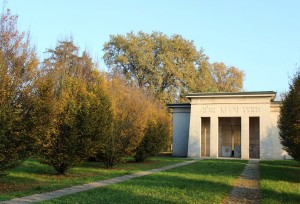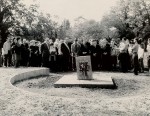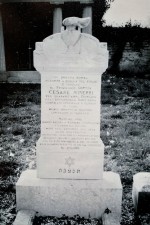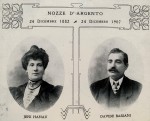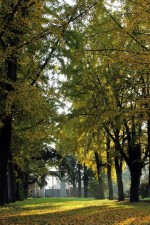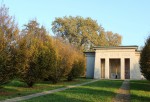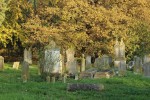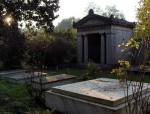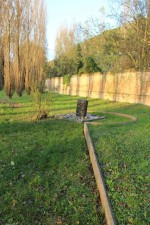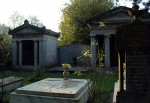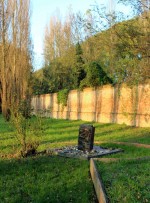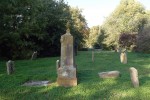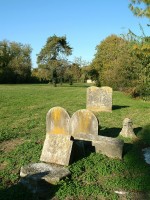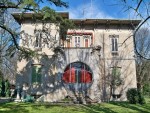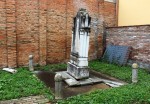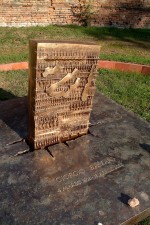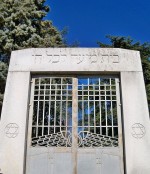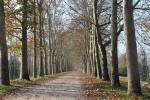The Jewish Cemetery of Via delle Vigne
The Jewish Cemetery in Via delle Vigne, still in use, is the oldest in Emilia Romagna, along with that in Finale Emilia. Situated behind a branch of the city walls, it is one of the most evocative sites of the Addizione Erculea built during the Renaissance period.
The Uncertain Origins
The bulk of historiography places the beginning of the use of the area of Via delle Vigne in 1626, when Ferrara’s Jews asked Pope Urban VIII for permission to purchase land for burial of their people; the licence obtained required that the assigned location not exceed 20 “staia” in area, and was to be specified by the local bishop or vicar. In any case, the oldest tombstone in the cemetery, that of David Franco which gives the date of death of 1549, would confirm the work of scholars who claim that it could date back to the 16th century.
The Structure
The cemetery can be divided into five main zones, the result of successive acquisitions:
- the long rectangular area just beyond the entrance, which dates back to the significant restoration in the early 20th century by Jewish Ferrarese architect Ciro Contini, contains the most recent burials: from the early 20th century to today.
- The area leading on from the tree-lined boulevard which leads to the mortuary chamber, dedicated to the victims of deportations, houses mainly 19th century tombstones.
- The grassy clearing to the left of the previous areas was used in the 18th century, and only a few tombstones remain visible due to the papal orders preventing additions in Jewish cemeteries, but also due to the destruction performed by the inquisition in 1755.
- On the east side there are some more 19th century burials, with some tombstones resting on or buried in the perimeter wall, and others on the ground.
- On the same side, an area almost triangular in shape which houses the tomb of Giorgio Bassani and the monument dedicated to him by sculptor Arnaldo Pomodoro.
Of the approximately 800 tombstones in the cemetery, little more than one hundred are in Hebrew, while the others bear Italian inscriptions, or are bilingual.
Quotes
“…In the gathering at the Jewish Cemetery, in Via delle Vigne, where the funeral took place for Ernest Nadasi, born in Pécel, Hungary in 1912. Prisoner in a concentration camp for three years during the war, he subsequently came to Ferrara to visit some of his fellow former prisoners, where he fell in love with a young Catholic girl, who became his wife and converted to Judaism. They subsequently moved to Hollywood, USA, where Ernest, as well as teaching mathematics at university, continued his musical career, having been the cantor of a community in his home country. He had expressed a desire to be buried in Ferrara, in this exquisite silence, where the idea which predominates is respect obtained as it is deserved, where everything contributes to the noble beauty of irreplaceable images. […] We proceed towards the exit of this place not of fear, but poetry, trust, amongst buried sounds, quiet reached for a moment, plants and flowers which are now soaked but will soon, with the coming of new warmth, be even more evocative in their infinite humility”. (Gianfranco Rossi, in Ravenna 1998)
Memorial to Giorgio Bassani
One of the many important people buried at this cemetery is Giorgio Bassani (Bologna, 4 March 1916 - Rome, 13 April 2000), honoured with a monument created by sculptor Arnaldo Pomodoro and architect Piero Sartogo in 2003.
In literature
One of the most sophisticated descriptions of this cemetery is by Bassani himself, in his novel The Gold-Rimmed Spectacles. In that vision, from atop the Mura degli Angeli walls, everything seems to be in the right place amid the silence and light of dusk, giving the first-person narrator (and thus the author) a profound sense of peace. ‘I ended up towards evening on the city walls, the Mura degli Angeli, where I had spent so many afternoons of my childhood and adolescence; and, in short, pedalling along the path on top of the bastion, I drew level with the Jewish cemetery. I got off the bike and leant against a tree trunk. I looked at the cemetery below, in which our dead were buried. Amid the occasional gravestones, made small by the distance, I saw a man and a woman, both middle-aged, walking about: most likely two visitors delayed between one train and the next - I told myself - who had managed to obtain from Dr Levi the permit required to visit the cemetery. They were passing between the tombs with the care and detachment of guests, of foreigners. Then suddenly, watching them and the vast urban landscape which displayed itself to me at that height in all its breadth, I was struck by a great sweetness, by a feeling of peace and the tenderest gratitude. The setting sun, cleaving through a dark cope of cloud that lay low on the horizon, vividly lit up everything: the Jewish cemetery at my feet, the apse and bell tower of the Church of San Cristoforo only a little further on, and in the background, high above the vista of brown roofs, the distant bulk of the Estense Castle and the Duomo. It was enough for me to recover the ancient, maternal visage of my home town, to reclaim it once again all for myself, for that atrocious feeling of exclusion that had tormented me in the last days to fall away instantly. The future of persecution and massacres that perhaps awaited us - since childhood I had heard them spoken of as an always possible eventuality for us Jews - no longer made me afraid.’ (G. Bassani, ‘The Gold-Rimmed Spectacles’, in The Novel of Ferrara, translated by Jamie McKendrick, Penguin Classics, 2018)
In his fictional reinvention, Bassani has placed the tomb of the most famous family of The Novel of Ferrara, the Finzi-Continis, in this cemetery. A symbol of the family even in its grandeur, it is mentioned in the prologue and described in detail in the first lines of chapter one. ‘...once again, in the quiet and torpor...I went over in my memory the years of my early youth, both in Ferrara and in the Jewish Cemetery at the end of Via Montebello. I saw once again the large fields scattered with trees, the gravestones and trunks of columns bunched up more densely along the surrounding and dividing walls, as if again before my eyes, the monumental tomb of the Finzi-Continis. True, it was an ugly tomb - as I’d always heard it described from my earliest childhood - but never less than imposing and full of significance if for no other reason that the prestige of the family itself. ..‘ (G. Bassani, prologue of ‘The Garden of the Finzi-Continis’, in The Novel of Ferrara, translated by Jamie McKendrick, Penguin Classics, 2018, e-book location 4062) ‘The tomb was huge, solid and truly imposing, a kind of temple, something of a cross between the antique and the oriental, such as might be encountered in those stage-sets of Aida or Nabucco very much in vogue at our theatres only a few years back. In any other cemetery, including the adjacent Municipal Cemetery, a grave of such pretensions would not have provoked the slightest wonder, might even, mixed in among the rest, have gone unheeded. But in ours it stood out alone. And so, although it loomed some way from the entrance gate, at the end of an abandoned field where for more than half a century no one had been buried, it made an eye-catching show of itself. It seems that a distinguished professor of architecture, responsible for many other eyesores in the city, had been commissioned to construct it by Moisè Finzi-Contini, Alberto and Micòl’s paternal great-grandfather, who died in 1863, shortly after the annexation of the Papa States’ territories to the Kingdom of Italy and the resulting final abolition, in Ferrara as well, of the Jewish ghettos. ...It is likely that the distinguished professor of architecture was given a completely free hand. And with all that marble at his disposal - white Carrara, flesh-pink marble from Verona, black-speckled grey marble, yellow marble, blue marble, pale green marble - the man had, in his turn, obviously lost his head. What resulted was an extraordinary mishmash into which flowed the architectonic echoes of Theodoric's mausoleum at Ravenna, of the Egyptian temples at Luxor, of Roman baroque, and even, as the thickset columns of the peristyle proclaimed, of the Greek constructions of Cnossos. But there it stood. Little by little, year after year, time, which in its way always adjusts everything, had managed to make even that unlikely hotchpotch of clashing style somehow in keeping.’ (G. Bassani, The Garden of the Finzi-Continis’, in The Novel of Ferrara, translated by Jamie McKendrick, Penguin Classics, 2018, e-book location 4079-4094)
Bibliography
- Istituto per i beni culturali della regione Emilia-Romagna, M. Bondoni, Simonetta - Busi, Giulio, Cultura ebraica in Emilia-Romagna, Luisè, Rimini 1987 Vai al testo digitalizzato
- Ravenna, Paolo, L’antico orto degli ebrei: il cimitero ebraico a Ferrara, Corbo, Ferrara 1998
- Bassani, Giorgio, Il giardino dei Finzi Contini, Mondadori, Milano 2001
- Giorgio Bassani, Gli occhiali d’oro in Opere, Il romanzo di Ferrara, Mondadori 2001
- Luoghi ebraici in Emilia Romagna, Touring Club Italiano, Milano-Bologna 2006
- Provasi, Matteo, Ferrara ebraica, 2G Editrice, Ferrara 2010
- Faccini, Agnese - Perani, Mauro, Gli epitaffi dei cimiteri ebraici di Ferrara: vicende e studio di una formidabile fonte storica, genealogica, letteraria e poetica (secc. XVI-XIX). Un primo contributo, in Fondazione Museo Nazionale dell’Ebraismo Italiano e della Shoah, a cura di Graziani Secchieri, Laura, Ebrei a Ferrara. Ebrei di Ferrara. Aspetti culturali, economici e sociali della presenza ebraica a Ferrara (secc. XIII-XX), Giuntina, Firenze 2014 Vai al testo digitalizzato
- Comune di Ferrara, Comunità Ebraica di Ferrara, Ferrara. Il ghetto Vai al testo digitalizzato
Fototeca
Related Subjects
Related places
Related Itineraries
Compiling entity
- Istituto di Storia Contemporanea di Ferrara
- Assessorato alla Cultura e al Turismo, Comune di Ferrara
Author
- Federica Pezzoli
- Sharon Reichel
- Barbara Pizzo

